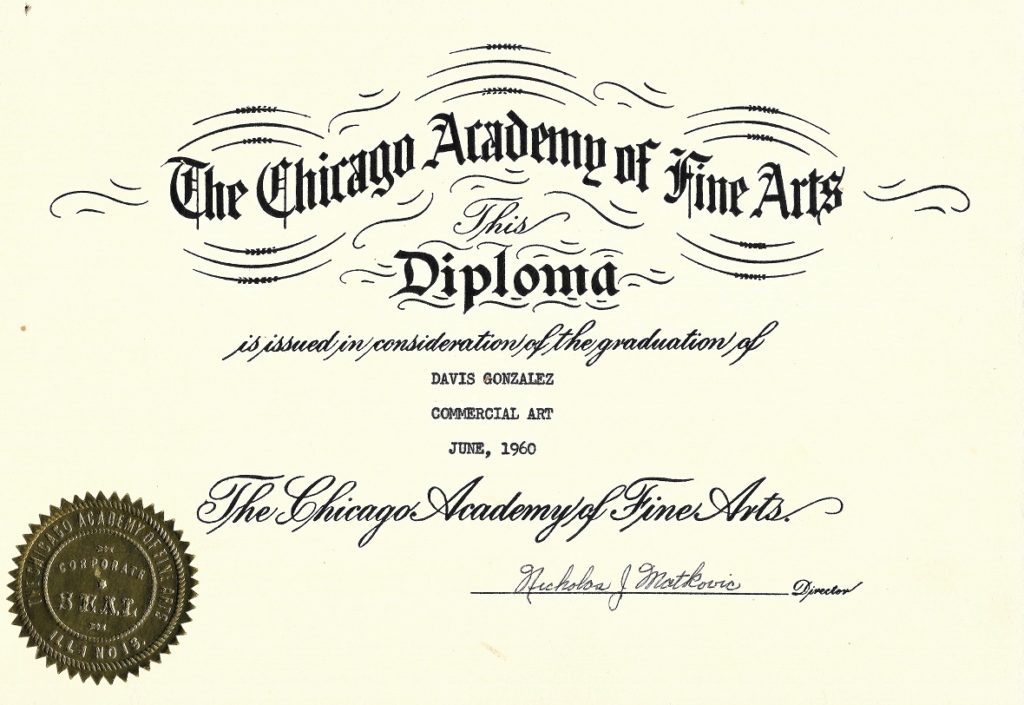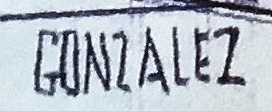From 1960 through the 1980’s, Davis Gonzalez’s iconic art was seen all over Chicagoland — but never in an art gallery. It would be hard to find a Chicagoan of that time who hadn’t seen Davis’s work — but few would recognize his name.

Davis was a commercial artist (an important distinction for him) and, more specifically, an architectural delineator. His work was commissioned by some of Chicago’s finest architects, transforming their dry blueprints into vibrant living spaces. Davis’s architect clients used his art to rally investors to move forward on building projects, explain their plans to zoning boards, and build public enthusiasm by displaying his art in both newspapers and construction-site billboards. Davis’s art regularly appeared in The Chicago Tribune, Chicago Sun-Times, and The Daily Herald.
Background
Davis was born in Chicago in 1934 – one of nine children in a large Catholic, Mexican-American family. He attended Carpenter Elementary and William H. Wells High School before taking a full-time factory job at W.F. Hall Printing Company on West Diversey Avenue.
While in school, Davis excelled in art and won several city-wide art contests. While working at W.F. Hall, he attended the prestigious Chicago Academy of Fine Arts at The Art Institute of Chicago (now known as The School of the Art Institute of Chicago), graduating in 1960.

At the time, in the days before computer graphics, commercial artists were in high demand and earned well respected careers. Commercial art appeared in almost in every magazine ad and on every billboard. Think of the art of the famous Santa Claus imagery in Coca-Cola ads or John Gilroy’s iconic Guinness Beer ads. While fine artists “starved” and suffered to find inspiration, commercial artists often had job security and a steady stream of work. In Chicago, Davis Gonzalez set out to apply his commercial art degree and skills in the area of architecture.
In 1960, Davis accepted a role with Albert Francik and Associates as an architectural delineator. There, he’d work with the firm’s stable of architect clients often producing 2 or 3 full-size paintings a week. This was often a collaborative process, with Davis suggesting embellishments and improvements to the client’s design, as the architect looked over Davis shoulder as he painted.
In 1970, Davis left Francik and Associates, bringing many loyal and appreciative clients with him, and started his own small freelance business. Davis dedicated a room in his suburban Elk Grove Village home as his studio. There, his schedule mimicked the economy. During recessions, work was hard to find. During good times, he often worked through the night to meet client’s deadlines.

Almost all of Davis’s original artwork left with his clients. They’d adorn the lobbies of the banks he painted or his clients’ Wall of Fame. In return, Davis often received an 8″ x 10″ glossy photograph of his work. Currently, Davis’s original art is scattered all over Chicagoland.
Davis retired in the late-1980’s as computer graphics took over the industry, enabling architects to receive immediate feedback on their designs and integrate final appearance into their design process.
Davis married Marie Dorynek in 1963. They have three boys, all living in the Chicago suburbs, and eight grandchildren. All proudly display some of Davis’s art in their homes. Marie passed in 2009.
Davis is enjoying a happy retirement in Elk Grove Village.
